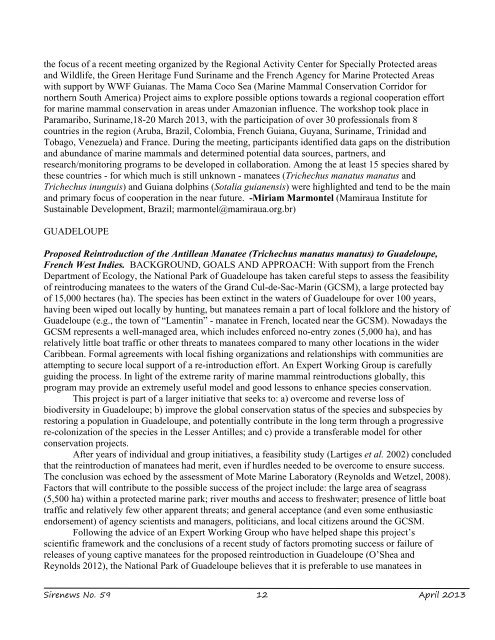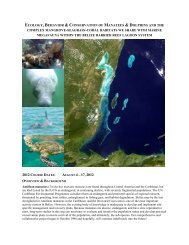PDF - Sirenian International
PDF - Sirenian International
PDF - Sirenian International
You also want an ePaper? Increase the reach of your titles
YUMPU automatically turns print PDFs into web optimized ePapers that Google loves.
the focus of a recent meeting organized by the Regional Activity Center for Specially Protected areas<br />
and Wildlife, the Green Heritage Fund Suriname and the French Agency for Marine Protected Areas<br />
with support by WWF Guianas. The Mama Coco Sea (Marine Mammal Conservation Corridor for<br />
northern South America) Project aims to explore possible options towards a regional cooperation effort<br />
for marine mammal conservation in areas under Amazonian influence. The workshop took place in<br />
Paramaribo, Suriname,18-20 March 2013, with the participation of over 30 professionals from 8<br />
countries in the region (Aruba, Brazil, Colombia, French Guiana, Guyana, Suriname, Trinidad and<br />
Tobago, Venezuela) and France. During the meeting, participants identified data gaps on the distribution<br />
and abundance of marine mammals and determined potential data sources, partners, and<br />
research/monitoring programs to be developed in collaboration. Among the at least 15 species shared by<br />
these countries - for which much is still unknown - manatees (Trichechus manatus manatus and<br />
Trichechus inunguis) and Guiana dolphins (Sotalia guianensis) were highlighted and tend to be the main<br />
and primary focus of cooperation in the near future. -Miriam Marmontel (Mamiraua Institute for<br />
Sustainable Development, Brazil; marmontel@mamiraua.org.br)<br />
GUADELOUPE<br />
Proposed Reintroduction of the Antillean Manatee (Trichechus manatus manatus) to Guadeloupe,<br />
French West Indies. BACKGROUND, GOALS AND APPROACH: With support from the French<br />
Department of Ecology, the National Park of Guadeloupe has taken careful steps to assess the feasibility<br />
of reintroducing manatees to the waters of the Grand Cul-de-Sac-Marin (GCSM), a large protected bay<br />
of 15,000 hectares (ha). The species has been extinct in the waters of Guadeloupe for over 100 years,<br />
having been wiped out locally by hunting, but manatees remain a part of local folklore and the history of<br />
Guadeloupe (e.g., the town of “Lamentin” - manatee in French, located near the GCSM). Nowadays the<br />
GCSM represents a well-managed area, which includes enforced no-entry zones (5,000 ha), and has<br />
relatively little boat traffic or other threats to manatees compared to many other locations in the wider<br />
Caribbean. Formal agreements with local fishing organizations and relationships with communities are<br />
attempting to secure local support of a re-introduction effort. An Expert Working Group is carefully<br />
guiding the process. In light of the extreme rarity of marine mammal reintroductions globally, this<br />
program may provide an extremely useful model and good lessons to enhance species conservation.<br />
This project is part of a larger initiative that seeks to: a) overcome and reverse loss of<br />
biodiversity in Guadeloupe; b) improve the global conservation status of the species and subspecies by<br />
restoring a population in Guadeloupe, and potentially contribute in the long term through a progressive<br />
re-colonization of the species in the Lesser Antilles; and c) provide a transferable model for other<br />
conservation projects.<br />
After years of individual and group initiatives, a feasibility study (Lartiges et al. 2002) concluded<br />
that the reintroduction of manatees had merit, even if hurdles needed to be overcome to ensure success.<br />
The conclusion was echoed by the assessment of Mote Marine Laboratory (Reynolds and Wetzel, 2008).<br />
Factors that will contribute to the possible success of the project include: the large area of seagrass<br />
(5,500 ha) within a protected marine park; river mouths and access to freshwater; presence of little boat<br />
traffic and relatively few other apparent threats; and general acceptance (and even some enthusiastic<br />
endorsement) of agency scientists and managers, politicians, and local citizens around the GCSM.<br />
Following the advice of an Expert Working Group who have helped shape this project’s<br />
scientific framework and the conclusions of a recent study of factors promoting success or failure of<br />
releases of young captive manatees for the proposed reintroduction in Guadeloupe (O’Shea and<br />
Reynolds 2012), the National Park of Guadeloupe believes that it is preferable to use manatees in<br />
Sirenews No. 59 12 April 2013













